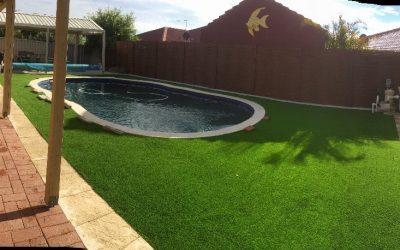One of the best features, synthetic Grass is that it does not require the care and maintenance of a natural grass lawn.
You never need to fertilize, mow, or waste huge amounts of water to have stunning green grass outdoors at home.
However, it does not mean that artificial turf is completely maintenance free; to keep your synthetic grass looking its best and to get the most enjoyment out of your investment, you will need to perform regular cleaning and maintenance.
How to Clean and Maintain Artificial Grass
It depends on how often do you need to maintain your grass.
I case of if you have outdoor pets, children, or lots of trees and shrubs, you will likely need to clean your synthetic lawn more often.
If happen to be in hi traffic urban area in Perth where you have a dusty situation then you might have to rinse down the synthetic lawn more often to keep it fresh & lush.(Especially in new building estates in Perth)
Conversely, during rainy months, you can allow the rain to wash your lawn and may not need to spray it down as often.
It depends on how often you need to maintain your grass periodically

14 Days Synthetic Lawn Maintenance
Most homeowners will need to lightly rinse down their synthetic lawns once per week.
Spraying down the grass fibers with a hose will remove dust and other small debris that has accumulated between grass blades.
Choosing The Right Equipment
1, Petrol or electric Blower
2, Hard bristle broom
3, Water Hose
4, power broom can be used to groom the grass
30 Days Artificial Lawn Maintenance
A more thorough synthetic grass cleaning, performed on a monthly basis, will help keep your lawn green, clean and inviting.
To remove dust, leaves and other debris, use a flexible lawn rake, a broom with stiff bristles or a stiff brush, or in some case, is better to use power broom if it needs more attention.
If you choose to use a stiff brush, make sure you do not choose one with steel bristles, which could damage the Synthetic grass.
Keep in mind that you may need to perform this level of maintenance more often if you have pets or during seasons when trees and shrubs lose their leaves or blooms.
Once you have thoroughly cleaned your grass, you may find that it is not standing as upright as you would like.
You may also notice that your grass is not erect in certain areas after you, a family member or pet has lain on it.
This is easy to fix by simply grooming your lawn by using a broom or handled brush to brush against the natural grain to encourage each blade of stand up properly.
Regular grooming also prevents matting and keeps your lawn’s infill from compacting.

How to Remove Pet Waste from Artificial Grass
pet owners can rest assured that little additional maintenance is required to keep their lawns looking great.
To remove pet droppings from grass, simply use your preferred method for removing solid pet waste.
This could be a plastic bag, for example.
Once you have removed the solid waste, hose down the area in which the pet waste was located.
Most pets have favorite places to relieve themselves, which makes pet urine removal simple as well.
We recommend every 2 weeks, cleaning and washing needed to perform in regards to your lawn to be clean and odor free from pets urine. It will help you avoiding urine accumulating and creating bacteria.
To ensure that your lawn stays clean and odor free, you may want to hose down your pet’s favorite urination area more often.
It is also recommended that you keep a bottle of turf deodorizer handy, which will allow you to avoid lawn odors with quick, regular treatments of the area.
Some pet owners choose to create a separate bathroom area for their pets in order to make fake lawn maintenance even easier.
This could be a dirt or gravel patch in a side yard or other area.
Dogs can often be trained to use these separate areas, making this a viable option for homeowners that do not want to clean pet waste from their synthetic turf.

Removing Stains
Artificial grass are meant to be lived on, which means drinks may be spilled, chewing gum or candy may be dropped, roughhousing may result in a bit of blood or mustard may drip from plates during family get together.
Artificial turf is stain resistant, which makes cleaning up spills and other accidents easy.
Most spills can simply be rinsed away with water.
If residue remains after hosing off the area, you can use a mild, natural soap with warm water or a half-and-half mix of vinegar and water, which is also a great option for removing bacteria.
The key to effectively removing spills is to respond quickly. Spills are easiest to remove when they are still in liquid form and can be simply washed away.
Chewing gum, candy, and other sticky substances can usually be removed just by picking them up with your hand; however, if a piece of chewing gum is being particularly difficult to remove, you can chill the gum with an ice cube to make it easier to remove completely.
You can also use a plastic putty knife or similar tool for tougher removals.
If this is required, make sure you use a dull object that will not cut or tear the synthetic turf. Do not use harsh chemicals or solvents to remove spills or sticky substances from your lawn.

Avoid Corrosive Chemical
If your artificial lawn has cigarette burns or stubborn stains, it can always be repaired; however, the better plan is to avoid spills and burns before they become a problem.
Certain spells, such as battery acid, grease, lubricants, motor oil and similar substances can discolor or damage synthetic turf.
Prevent contact with these substances by repairing vehicles and garden tools away from your fake grass.
Artificial grass burns can occur from cigarettes, smoldering charcoal spilling from a grill, fireworks or sparks from fire pits. To avoid these accidents, relegate smoking, lighting fireworks and grilling to areas that are a safe distance from your synthetic lawn.
How to Prevent Burns From Reflections
Artificial grass can become warm when in direct sunlight on high-temperature days.
This can lead to some homeowners being concerned about the potential to burn in the hot surfaces.Even the hottest direct sunlight will not burn your synthetic turf; however, it is possible for sun magnification or strong reflections from windows and sliding glass doors to damage your grass.
This magnified sunlight coming from your own windows or those of a neighbor can also burn your artificial turf if left unchecked.
The easiest way to avoid having your synthetic grass burned by window magnification is to find simple solutions that allow you to block potential window glare.
If the windows threatening your fake grass are on your home, you can install awnings, shutters, screens, or shades to minimize reflections.
If the potentially harmful windows are on a neighbor’s home, consider planting trees or bushes to protect your grass from focused window reflections.

Infill Sand if Required
In some cases of the artificial grass been installed for long few years, it might be worth looking into the bottom of the grass whether it needs the sand infill. As it can wash away especially if it has been installed on the slope. it must have 10 mm of kiln dried sand to protect the backing system from strong UV rays. protect your hard earn investment.
Finally
With little care and maintenance, you can extend the life of your synthetic lawn and keep it looking its best for years to come.
Performing these simple tasks on a regular basis will help ensure your lawn remains clean, lush and odor free, which will make it an inviting place to relax, play, sunbathe, or hang out with family and friends.
You can always call in a professional for a thorough cleaning, grooming or repair; however, you can keep costs to a minimum by taking steps to prevent artificial lawn damage and following a regular synthetic lawn maintenance routine.

Ready to take a step to Install synthetic turf
Are you ready to makeover your garden with some artificial grass? Learn more about our Synthetic grass















